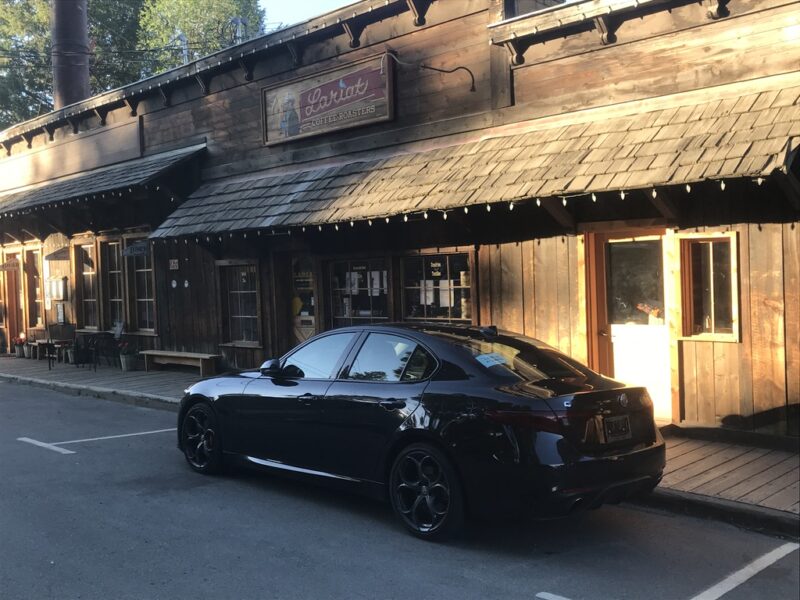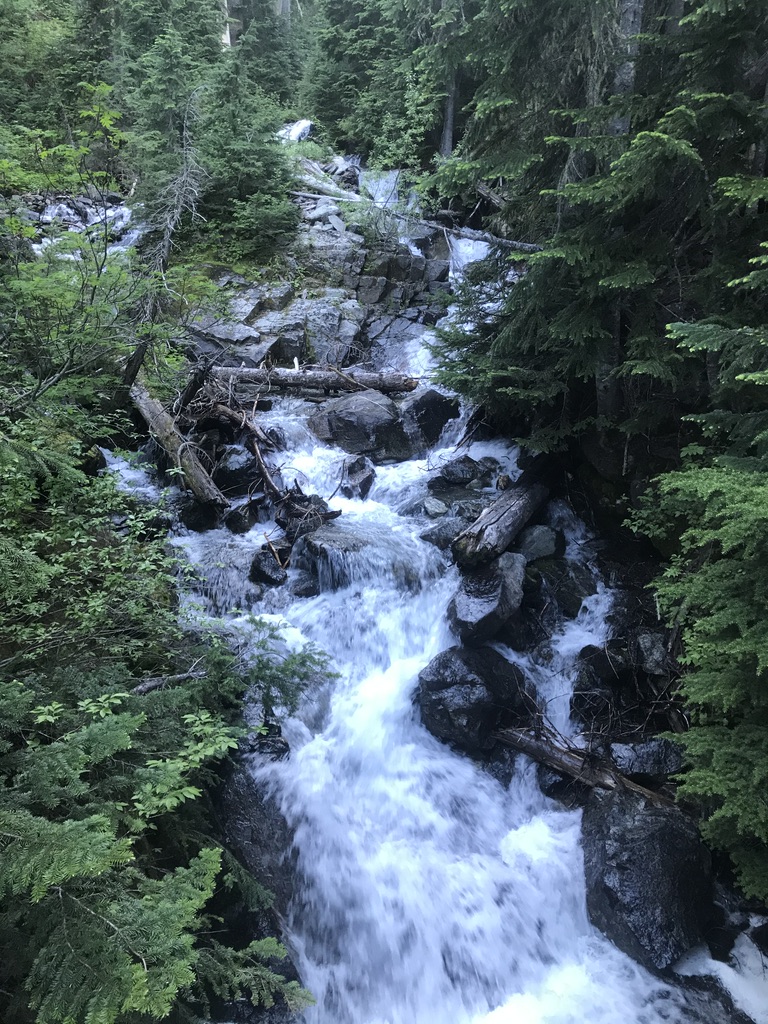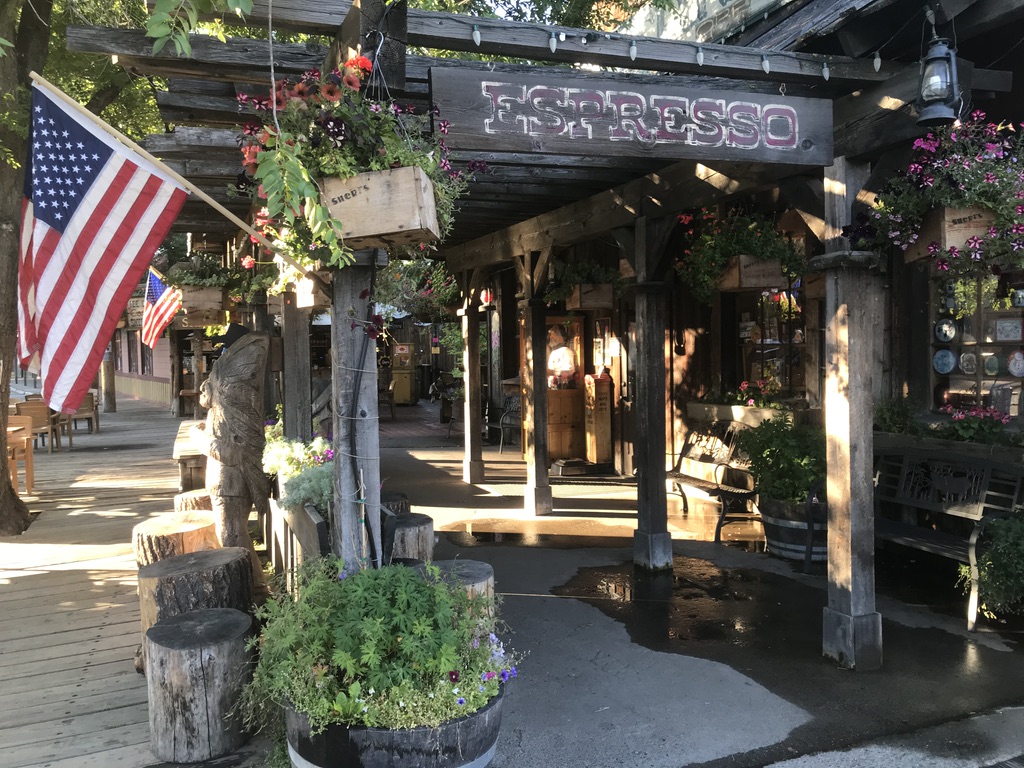Home • Travel Blog • Giulia & Julie •
The weekend highlight was driving the North Cascades Highway (WA 20).
Giulia hit the road on a Friday afternoon destined for Wenatchee, WA to rendezvous with my friend N with the goal of driving over the North Cascades Highway on Saturday. This initial part of the road trip is not a particularly scenic or exciting drive from my hometown as most of the highways pass through dry desert landscapes. So I set about to find a more circuitous route.

Washington Farmland
What I discovered was the diversity and beauty of south-central Washington farmland. Orchards of cherries and apples. Vineyards. Farms growing hops, berries, carrots, beets, grass seed, and turf grass to name a few.
And did you know that Washington has the largest US market share of red raspberries? I didn’t! According to Washington State Magazine, nearly 60% of U.S. red raspberries are produced in Washington.
As I meandered the small roads through the farmland, it struck me that we pay little thought to where and how the beautiful produce in our grocery store is grown. Driving through agricultural areas is both beautiful and eye-opening. In 2020, Washington generated approximately $9.9 billion in agriculture. Thirty-four percent of the land is farmed and the highest valued commodity is apples.
If you asked me to repeat my route to Wenatchee that evening, I truly have no idea. I know I passed through Othello, close by Quincy, and up along the Columbia River past Rock Island Dam and into Wenatchee. But it was an enjoyable drive, observing and reflecting on all the agriculture in my state. It’s relaxing to wander in a general direction without much thought as to what specific road you are driving on.
There are several great parks and walking trails in Wenatchee along the Columbia River where the dogs particularly enjoyed a lovely evening walk.
Cinnamon Twisp
The next morning, we continued to drive north on Hwy 2/97 along the Columbia River towards Chelan Falls. This is a particularly beautiful stretch of highway in the morning light as it winds along the river featuring views of fishermen, water skiers, and vineyards. It’s a great stretch of highway for a reflective leisurely drive.
At Pateros, we turned onto Hwy 153 towards Twisp and the Methow Valley. Our first stop for the day was the Cinnamon Twisp Bakery. This bakery, famously known for its Cinnamon Twisps, is the must-stop place in the town of Twisp.
These delightful asymmetrical pastries are twisty and gooey, just bready and cinnamon enough, chock full of nuts, and not too sweet (something I am partial to in my pastries.)
We seated ourselves at a shady sidewalk table alongside the festive turquoise and purple building and dug into our delicious treat. On this warm day, we combined our pastry with specialty drinks of iced coconut chai and iced blackberry mocha. The flavors were a perfect compliment.
North Cascades Highway
We continued up Hwy 20 through Winthrop (where we would stay the night) and up into the North Cascades Highway. The road features rugged peaks, glacial green lakes, hairpin turns, and numerous stunning viewpoints. It passes through and accesses North Cascades National Park, founded in 1968 to preserve the scenery, glaciers, waterfalls, and other natural features unique to this area.
Our next stop was the Washington Pass overlook and the incredible views of Liberty Bell Mountain and the deep wooded valley below. It is also a great view of the tortuous road, that is the North Cascades Highway, built through these mountains. This overlook is wheelchair accessible and there are many great hiking trails in the area.

Besides the grand vistas, I enjoyed taking in the ecological texture at this overlook. Bright green lichen clung to the remains of twisted striated logs. Sparkling mica accentuated the raw edges of steep granite rock slides. Little alpine chipmunks daftly scurried around the harsh landscape collecting edible treasures.
We continued on to one of the popular stops overlooking Diablo Lake. Here we enjoyed a picnic lunch of baguette, cheese, veggies, and hummus, the perfect road trip food.
Technically a reservoir formed by the Diablo Dam on the Skagit River, Diablo Lake is best known for its particularly intense hue of glacial green. This is formed from the glaciers grinding rocks into a fine powder that is carried down the streams and which, due to its fineness, stays suspended in the lake.
Giulia enjoyed the curves of the North Cascades Highway and we continued west to Newhalem before we turned around and headed back over the pass.
As we retraced our drive the opposite way, we stopped at Ross Lake (another reservoir that is not glacial green) for a brief hike down towards the lake. Ross Lake Resort is famously known for its floating cabins. The cabins are accessed via boat and were originally built in 1937. Docking at a cabin requires a year or two on a waiting list and a bit of flexibility.
Our last stop on the North Cascades Highway was at the Rainy Pass trailhead and we briskly walked the one-mile (wheelchair-accessible) trail to Rainy Lake, just in time to catch the brilliant colors and changing reflections of the last rays of sun on this classic alpine lake.

As we steered Giulia back towards the Methow Valley, we were tired, hungry, and happy. Pizza with a view in Mazama sounded like just what we needed.
Woodstone Pizzeria has a fabulous outdoor patio with a beautiful view of the sunset and mountains and was pet friendly. Thirsty and tired from our adventures, I enjoyed an affogato. I believe in dessert first and the caffeine combined with cold ice cream re-energized me while waiting for our steaming pizza.
Western town of Winthrop
Winthrop is a preserved Western town with authentic storefronts and wooden boardwalks which resemble the era of the 1850s. It is also a popular launch pad for the North Cascades and many outdoor adventures including being one of the largest areas for winter cross-country skiing.
Wanting to enjoy Winthrop without the crowds, we awoke at 6:30 the next morning and left the AbbyCreek Inn to walk downtown in the cool morning air and sunrise light.
We took our time enjoying the architecture, the history, window shopping, and views of the Methow river all while having the town nearly to ourselves. Truly a delight for a pair of introvert friends.
We strolled into the Rocking Horse Bakery and enjoyed pastries and a delightful cappuccino. The flavor was deep and earthy with just the right balance of thick rich foam accompanied by the sound of the river and the smell of the pine trees.

Detour to Grand Coulee Dam
As we parted ways for home, I again debated on a route, making the last-minute decision to detour to Grand Coulee Dam, a place I hadn’t been since a child.
No matter the political opinion about dams, it is a visually impressive structure. It was built to produce hydroelectric power and produce irrigation and is the largest power station in the US by nameplate-capacity.
As a child, I remember the laser light show that was projected onto the dam’s wall depicting the history of the region and which I thought was very cool.
The visitor’s center was closed on this visit due to the pandemic, but the dogs and I enjoyed a picnic lunch in the park and reflected on human’s persistent attempts to engineer and corral the power of nature.

The drive continued south along Soap Lake and through the rather desolate landscape of the coulees. These coulees are channeled areas in the bedrock carved out by the Missoula floods. The floods resulted in deep, braided ravines and columnar rock formations that crisscross the landscape making it decidedly unfriendly for farming. A future trip to explore the history and geology of the coulees and Washington scablands has definitely been added to the list.
Reflections
Our weekend road trip across the middle of Washington state and along the North Cascades Highway illustrates the great geological and ecological diversity. Thanks to our large rivers, we have beautiful and productive farms. Our glaciers past and present give us beautiful green lakes, twisty peaks, and bizarre scablands. All combine to provide great vistas and fascinating natural history to learn and enjoy.
Consider taking the winding back roads or adding in a little detour. You will discover fascinating new viewpoints of how the universe flows together.





















